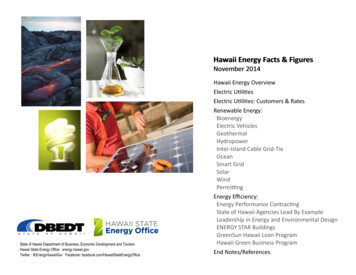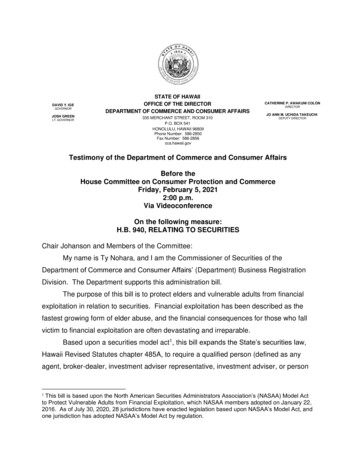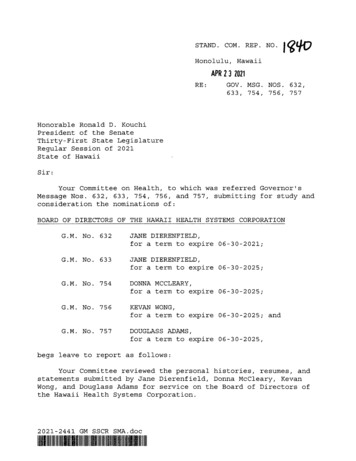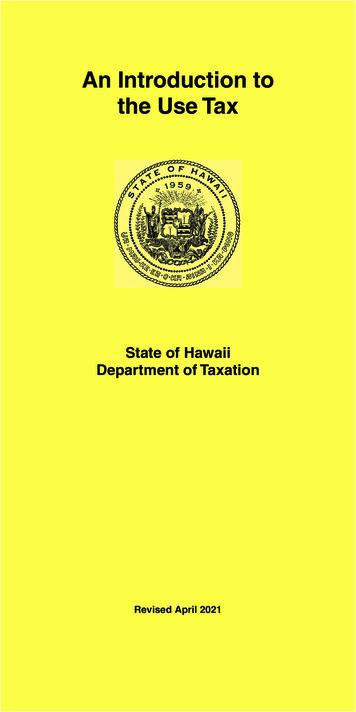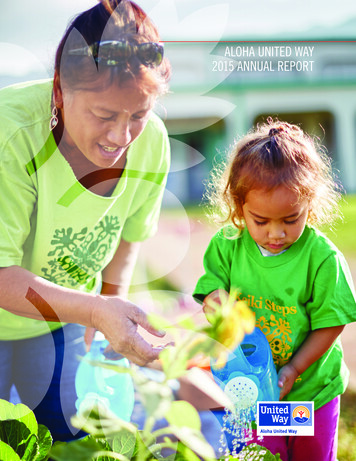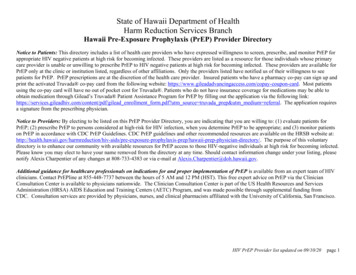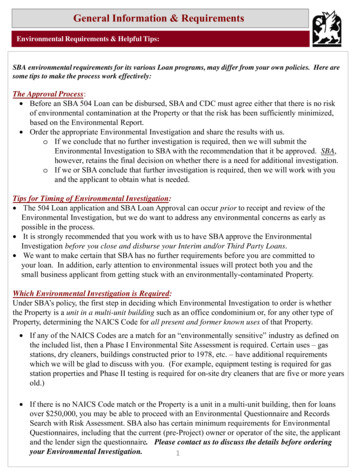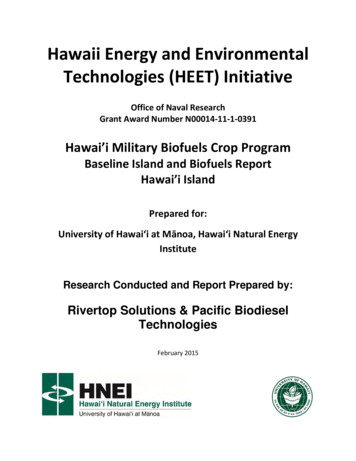
Transcription
Hawaii Energy and EnvironmentalTechnologies (HEET) InitiativeOffice of Naval ResearchGrant Award Number N00014-11-1-0391Hawai’i Military Biofuels Crop ProgramBaseline Island and Biofuels ReportHawai’i IslandPrepared for:University of Hawai‘i at Mānoa, Hawai‘i Natural EnergyInstituteResearch Conducted and Report Prepared by:Rivertop Solutions & Pacific BiodieselTechnologiesFebruary 2015
’i Military Biofuels Crop ProgramBaseline Island and Biofuels ReportHawai’i IslandPrepared For:Department of the NavyAndUniversity of HawaiiHawaii Natural Energy InstitutePrime Award Number N00014-11-1-0391Sub Award Number MA150004Prepared By:
ment of Work Task 1TABLE OF CONTENTSExecutive Summary .3I. Project Summary1.1 Overview . 61.1.1 Historical Perspective .61.1.2 Objectives of Baseline Test . . . .111.1.3 Phase one test sites . . . . . 131.2 Farming Test Concept.151.3 Sunflowers for Biofuelst .16II. Hawaii Island Agriculture Capacity2.1 Background . 352.2 History and Current Condition .422.2.1 Historic Use. 422.2.2 Current Agriculture Lands .432.2.3 Current Irrigation and Water Availability .452.2.4 Current Processing Infrastructure .46III. Existing Site Conditions3.1 Physical and Environmental Attributes .473.1.1 Soils .473.1.2 Slope .533.1.3 Rainfall .533.1.4 Climate .543.2 Infrastructure Assessment .553.2.1 Water . 553.2.2 Road.573.2.3 Energy . 573.3 Siting Considerations and Regional Consistency3.3.1 Consistent with the Existing Site Conditions .583.3.2 Potential for Expansion .58IV.Resources and References4.0 Resources and References.59V. Attachments . . 62
tive SummaryThe Hawaii Island crop testing plan builds upon the progress made in the Hawaii MilitaryBiofuel Crop (HMBC) demonstration project and will explore the use of sunflowers as alarge scale crop with the interest being the development of fuels from local renewablesources. This study provides an overview of the agriculture potential on Hawaii Island,along with a description of the test plots and an overview of the initial test plot growingplan.Hawaii Island has significant potential for crop production. The island has 1,184,599 acresdesignated for agriculture. The vast majority of the lands are currently in pasture or fallow.Historically over 80,000 acres were used for sugar cane, and over 40,000 acres inWaimea/South Kohala are suitable for growing sunflower with an investment ininfrastructure. It is anticipated that the year round growing season will allow for 2 growingcycles with roughly 100 days of rest for each parcel. The growing cycle for sunflower islargely dependent on solar energy, so each crop will be roughly 120 days from germinationto harvest. Initial research indicates that the best planting will be achieved with 27,000seeds per acre, and produce roughly 1800 lbs of seed and 24 tons of silage per acre. Theseed are expected to produce 800 lbs of oil and 1000 pounds of seedcake. Thesepredictions will be tested in the initial crop growth tests. If correct, a 5,000,000 gallonbiofuel plant could be supported with roughly 25,000 acres.Sunflowers have been selected as there is potential to use the entire biomass to createenergy and other products. This results in the potential for lower costs for the energycomponents. In the case of sunflower three markets would be oil for liquid fuels (F-76,biodiesel), silage as feedstock for synthetic gas production and conversion to electricity orfuel, and seedcake for livestock feeds. The specific products are:BIOMASS- Vegetable Oil for sale as either a fuel feedstock or as an oil for use in cooking- Seedcake for sale as livestock feed- Pelletized silage for use in the gasification plant. Any production exceeding the capacityof the gasification plant will be sold to other biomass users on the Island and in the State.FUEL- Aviation fuel for the commercial and Department of Defense Markets- Transportation Fuels as needed for the local vehicle market- Methane for the local heating and electrical generation markets
BiofuelsReportRELATED PRODUCTS BaselineIslandandBiofuelsReport-Ash and fertilizer byproducts from the gasification process-Glycerin and fertilizer from the biodiesel processIn order to determine the best potential regions on the island for ramping up to commercialscale production, the project has identified the following regions on which to develop 1acre test sites:1) North Kohala at Sea Level and at 1500 ft. altitude2) South Kohala at 3000 ft. altitude ranging from 25 inch to 40 inch annual rainfall3) Hamakua Coast in the vicinity of Honakaa and North Hilo4) Puna DistrictThe overall work plan is summarized below. The first step will be to develop, plant, raiseand harvest test crops on the 1 acre test sites.WorkPlanTimeline–9MonthsMonths1- ‐3Months4- ‐6Months7- ‐91. HIIslandBiofuelCropPotentialReport2. CropRegionalLandIdentification3. CropCommercializationSiteSelection4. PotentialFuel&ByproductOptionsfromBiomass5. EconomicsAssessmentReport6. SitePreparation&Development7. SupplyChainPlan8. AgricultureProcessInfrastructurePlan1. spotentialfromidleagriculturelands.2. HighProbabilitySiteSelectionReport.3. SiteSelectionReport.4. ReviewTRL7- ‐9optionsforcropspecificconversionofnon- els,syngas,methane,methanebyproducts&hydrogen.5. oreducecostoffuels.6. SitePreparationDevelopmentPlan.7. SiteSpecificIrrigationEngineeringPlan.8. CompletedPermitsandLeaseReport.9. SiteSpecific3- ‐yearCropCommercializationPlans.10. oCommercializationplan.11. ofbiofuelcrops.12. Jatrophacropviabilityassessment.
BiofuelsReportBaselineIslandandBiofuelsReportEach site will be developed to identify a select set of key evaluation metrics. Thesemetrics are designed to identify the most likely regions for future expansion to commercialscale. The most important determination is the cost per ton to grow the crops. Not toodistant from the primary goal is the need to create a crop growth system that improves theland and allows for long-term maintenance of the supply chain. The key evaluation featureswill be:1)2)3)4)5)6)Irrigation requirement per acreFertilizer requirement per acreRate of growthCrop loss per acreTime required for cover/rotation crops to restore landInfrastructure cost per acreThe following are the selected test sites1)2)3)4)5)6)7)8)9)North Kohala Low Altitude – 500 ft.North Kohala Medium Altitude – 1500 ft.Waimea Dry Side DHHL – 2880 ft.Waimea Mid-range rainfall DHHL – 3100 ft.Waimea Wet Side – 3000 ft.Hamakua Mid-altitude – 2500 ft.North Hilo – 800 ft.Puna low altitude – 650 ft.Puna mid altitude – 900 ft.This report outlines the baseline information from which the site selection will be finalized.
BiofuelsReportBaselineIslandandBiofuelsReport1. Project Summary1.1 Overview1.1.1Historical PerspectiveFigure 1: Historic Land Use for Hawaii Island from theBaseline Study for Food Self-Sufficiency (UH-Hilo 2012)
tFrom first settlement until themid-1800’sIsland wasthe critical agricultural islandin the State. The island produced food for all the residents, which is currently estimated tobe somewhere between 400,000 and 1,000,000. Beginning the mid-1800’s sugarcanebecame a dominant crop in Hawaii, along with pineapple, and drove a significant shifttowards large mono-crop agriculture. This industry remained on the Island until 1994 whenthe last of the plantations left the island. Following the collapse of the industry, much ofthe land was purchased by the Bishop Estate and other smaller trusts. Many governmentprograms were put in place to create new industry with little success. The lands on theHamakua Coast have, in large part, been planted in Eucalyptus with over 19,000 acres stillin the timber.Another trade that opened land for agriculture was the strong Sandalwood trade with Indiaand China that lasted from 1811 through the early 1830’s. This trade destroyed theSandalwood forests, and left over 100,000 acres of land on Hawaii Island that wereconverted to ranching. Much of this acreage was in the Waimea region, and now is held bytwo major landholders, the Department of Hawaiian Home Lands and Parker Ranch.Prior to the arrival of Europeans, South and North Kohala had extensive agriculturalproduction. The region was seen as a breadbasket. For this study a member of a long-timeWaimea Hawaiian Family, Robert Lindsey, was interviewed about the history of the region.Mr. Lindsey is now the Chairman of the Office of Hawaiian Affairs, the State agencyresponsible for the physical and historic wellbeing of Native Hawaiians.Robert Lindsey:“Waimea Nui; our ‘aina momona’ (a place of abundance) is traditionally agriculturefocused place nestled in the lee of the Kohala foothills and the shadow of Mauna KeaMountain. Waimea Nui is our Canaan, ‘our Promise Land of milk and honey.’Our people settled this ‘wahi pana’ (sacred place) many, many centuries ago. They camefrom Hawai’iki guided by the stars, winds, birds and currents in great sea faring canoesbringing with them our ancient gods, protocols, ethics, values, principles, folkways, andmores. They were proud, industrious and hardworking. And in this most isolated corner
BiofuelsReportBaselineIslandandBiofuelsReportof the world’s vastest ocean, our people established a ‘lei’ (a wreath worn around theneck) of chiefdoms that has endured and flourished across time.In 1778, the Explorer James Cook stumbled upon us when searching for the NorthwestPassage. James Cook came from a culture of “Guns, Germs and Steel” whereas ourculture was built on stone and fiber. And with his arrival, the well-kept secret of Hawai’iwas gone forever; he opened our shores to the world and put us on a path toglobalization. James Cook was the beginning of category 5 force changes that wouldsweep through our homeland, a homeland that was once described by Mark Twain as the“most beautiful of islands anchored in any ocean.”In 1810 our Warrior Chief Kamehameha Paiea accomplished what others had tried butfailed to achieve: he unified our islands (Kauai being the exception). In November 1819,the ‘Keepers of The Ancient Ways’ and the ‘Advocates for Change’ resolved theirdifferences in the Battle of Kuamo’o, with the traditionalists on the losing side. In April1820 (six months later) the first boatload of New England missionaries arrived atKamakahonu, Kailua-Kona. Some say it was destiny, a void existed, the God of Abrahamand Isaac made landfall and filled the existing abyss.The 19th Century was the ‘Pacific Century’ and Hawai’i was at its epicenter. The“Sandwich Islands”, as Hawai’i was known at the time, served as a replenishing stationfor ships pursuing commerce (whaling, sandalwood) and plying trade between West andEast (the Americas, Europe and Asia). More changes would take our islands by storm,our populace would be decimated by foreign maladies, our ‘Ali’i’ (Chiefs) would face acontinuing struggle against nations lusting after our geographic position in the Pacific(Monroe Doctrine and Manifest Destiny), and within the islands sugar’ became ‘King’and pineapple its ‘Queen.’ The significant events include: 1831 Lahainaluna School established; western education formalized in theKingdom of Hawai’i.1839 first printing of Bible in Hawaiian, French Admiral La Place threatensto bombard Honolulu if the harassment of French Catholics is not stopped byKamehameha III.; Chief’s Children School established with instructionprovided by American missionaries.1840 First Hawaiian Constitution adopted based on Hawaiian and Westernprinciples.1843 Lord Paulet seizes Hawai’i for England. Admiral Thomas restoresHawai’i’s sovereignty that same year.1848 the Great ‘Mahele’ (Division), land ownership replaces our indigenousland system whose essence was “the land was chief and we are its servants,”we are caretakers not possessors of land; Parker Ranch is established.1876 Reciprocity Treaty negotiated with U.S. for use of Pearl Harbor Basinas a coaling Station.
BiofuelsReportBaselineIslandandBiofuelsReport1878 telephone service installed at Iolani Palace.1883 King Kalakaua and Queen Kapiolani are coronated in Honolulu.1887 Bayonet Constitution proclaimed by Reform Party; King Kalakaua’spowers diminished greatly as a result.1891 Kalakaua dies and is succeeded by his sister Lili’uokalani.1893 Liliuokalani overthrown by American businessman, U.S. MinisterStevens and U.S. Marines.1894 Republic of Hawai’i established.1898 Kingdom of Hawai’i annexed to the United States via NewlandsResolution, majority of Hawaiians voted against annexation.1900 Hawai’i becomes U.S. Territory.1920 Hawaiian Homes Commission Act passes out of the U.S. Congress.1943 Waimea is a major training center for U.S. Marines (2nd & 5th Divisions)participating in the Pacific Campaign against Japan (Tinian, Saipan and IwoJima), electrical and domestic water systems were introduced to our paniolotown.1959 Hawai’i becomes 50th State of the American Union’ and responsibilityfor carrying out the mandates of the Hawaiian Homes Act is passed from theFederal to newly formed State Government and the Department of HawaiianHome Lands (1960).1970 Hawaiian Renaissance spreads across the Hawaiian Archipelago.1978 Constitutional Amendment creates the Office of Hawaiian Affairs, aquasi-State Agency “to better conditions for Hawaiian people.Like our ancestors, we the beneficiaries of Waimea Nui are proud, industrious and hardworking. Despite all the changes which have rolled across our homeland over centuries,we choose to see our ‘glass as being half full’ and filling all the time. We are not bitteror chagrined about the history of our past. We are poised to take these events and turnthem into future opportunities for our people.We need to ‘Holomua’ (move forward), no longer as victims but as victors through anoble and worthy effort to resurrect and reform our nation in a contemporary context:repair our spirits, bring back some of what was lost that was good and blend that withthe best of this Global and New World we reside in today. Waimea Nui provides us that‘on ramp’ to the future, a future built on aloha, compassion, selflessness and goodwill.For the good of our people and all who call Hawai’i home, this is what we must and willdo. The days of handouts and free lunches are ‘pau’ (gone). We live in a hand up world,where we must do for ourselves, where we must do more with less and less with less, andwhere we can share what we learn with others around the world. Building on ourtradition of agriculture with sunflowers.”
BiofuelsReportBaselineIslandandBiofuelsReport1.1.2 Objectives of Baseline TestThe baseline report serves to document the research conducted to determine the best sitesfor the test crops. In preparation for the test, the Hawaii Biofuels team has conducted sitesurveys of over 30 potential sites across the island. Many of the sites had aspects thatappeared viable, but were eliminated because they would not provide suitable results. Thesite survey narrowed down the sites based on the following criteria:1) Ability to expand beyond the test site to larger acreage.expansion size is 50 acres.The minimum2) Rainfall which enabled reduced irrigation, but did not exceed the plants waterrequirements3) Soils which had not been stripped of nutrients by either erosion, sugarcaneproduction, or excessive rainfall.4) Existing infrastructure supports access to the site with required equipment.5) Lands are diverse enough to represent the majority of suitable land on theisland. This required several sites to be eliminated as they were too similar inenvironment and soil condition. Elevation is a key discriminator.6) Land with slopes of less than 1% to reduce costs of land preparation.For the test, the team held a series of discussions with mainland sunflower farmers andseed companies. The specific objective has been to identify the appropriate varieties topursue. For the test oil production is the key factor, with overall biomass production beinga secondary issue. Additional criteria were suitability for Hawaiian soils, resistance toorganic herbicides, maturity rate, and resistance to winds. For the test three varieties wererecommended and selected.1) Cobalt II - Clearfield, high oleic, early maturity2) Hornet - Clearfield, high oleic, medium-full maturity3) Camaro II - Clearfield, NuSun (midoleic), medium maturityAs part of the seed identification process it was determined that seed size should either be 3or 4. This is due to the soil and sun conditions, with this seed size being ideally suited forproduce growth and for seed spacing of 27,000 per acre.21
BiofuelsReportFinally the sites that have beenselectedare flatsurroundedby lands that can be tilled ifBaselineIslandandandBiofuelsReportneeded. The test will be conducted using no-till as the primary means to determine if this isadequate to enable crop growth.22
BiofuelsReportBaselineIslandandBiofuelsReport1.1.3 Phase One Test SitesThe following sites have been selected for the test. They are listed from North to South,which is the primary mechanism for property identification on Hawaii Island. The sitesrange from North Kohala to Puna.Figure 2: Hawaii Island RegionsThe following are the selected test sites1) North Kohala Low Altitudea. 500 ft. altitudeb. Available irrigation from County sourcesc. Land has been in pastured. 20 inch annual rainfalle. Equivalent land in area: 325 acres2) North Kohala Medium Altitudea. 1500 ft. altitudeb. Available irrigation from Watt Water Tunnel overflowc. Land has been in pastured. 25 inch annual rainfalle. Equivalent land in area: 460 acres23
elineIslandandBiofuelsReportWaimea Dry Side DHHLBaselineIslandandBiofuelsReporta. 2880 ft. altitudeb. Available irrigation from State Agriculturec. Land has been in agricultured. 25 inch annual rainfalle. Equivalent land in area: 12,750 acresWaimea Mid-range rainfall DHHLa. 3150 ft. altitudeb. Available irrigation from State Agriculturec. Land has been in agricultured. 30 inch annual rainfalle. Equivalent land in area: 7,650 acresWaimea Wet Sidea. 3100 ft. altitudeb. Available irrigation from State Agriculturec. Land has been in pastured. 45 inch annual rainfalle. Equivalent land in area: 5,150 acresHamakua Mid-altitudea. 2500 ft. altitudeb. Available irrigation from State Agriculturec. Land has been in pastured. 60 inch annual rainfalle. Equivalent land in area: 3,900 acresNorth Hiloa. 1100 ft. altitudeb. Available irrigation from on-site irrigation ditchc. Land has been in agricultured. 75 inch annual rainfalle. Equivalent land in area: 650 acresPuna low altitudea. 650 ft. altitudeb. Available irrigation from State Agriculturec. Land has been agricultured. 80 inch annual rainfalle. Equivalent land in area: 7,000 acresPuna mid altitudea. 900 ft. altitudeb. Available irrigation from State Agriculturec. Land has been in agricultured. 75 inch annual rainfalle. Equivalent land in area: 2,500 acres24
BiofuelsReportBaselineIslandandBiofuelsReport1.2 Farming Test ConceptThe test crops will be planted in 9 rows with seed spacing that will match a 27,000 acrerate in each row. The rows will have wider than normal separation to allow testing. Eachrow will be divided into 3 separate irrigation zones; a) no irrigation b) moderate irrigation,and c) standard irrigation. Each of those subzones will be further subdivided into 3fertilizer levels; a) no fertilizer, b) low fertilizer, and c) standard fertilizer. Because of thesubstantial difference in annual rainfall in these regions, some may not require watering atall, others will use one heavy watering during planting, or as is required for the higherrainfall/lower soil areas.25
BiofuelsReportBaselineIslandandBiofuelsReport1.3 Sunflower for BiofuelsIntroductionSunflower, one of the most common oilseed crops, can be easily incorporated into thelocal cropping systems, and produce added benefits such as enhanced soil health andincreased biodiversity in the rotation. (Oilseed production in the northeast: March 2010)According to the USDA national agricultural statistical service, there were 1.6 million acresof oilseed sunflowers harvested in the United States in 2012. (Tennessee State University.Bioenergy- Sunflower for biodiesel prod. 2014)Hitting closer to home, according to a November report produced by the HawaiiAgricultural Research Center for the State Department of Agriculture, 150 million gallons ofbiodiesel per year represents 55% of diesel used in the state in 2004.Capacity for biofuelBiodiesel is a clean burning renewable fuel made through a chemical process whichconverts oils and fats of natural origin into fatty acid methyl esters. Biodiesel is a directreplacement for fossil diesel fuel in vehicles and power generators. Reducing the UnitedStates’ fuel consumption would mean biofuels over time would make up a larger portion ofoverall transportation fuel.The production of biodiesel in the US was almost 1.8 billion gallons in 2014. Thisequates to 0.7% of the total US transportation fuel use. The United States productionexpanded from 215 million gallons in 2011 to 1.1 billion gallons in 2012. Installed capacityis generally listed as 1.5 to 2 times the current production. There are currently 159companies working to produce advanced biofuel in the United States and Canada. Not onlyhas the Department of Defense (DoD) invested heavily in advanced biofuel projects, butalso the military is the nation’s single largest consumer of fuels. Much individual analysis’reveals slow and steady growth for the advanced biofuel industry. (Advanced biofuel report2013)Commercial users such as the maritime, aviation, construction and electric powerindustries consume most diesel fuel in Hawai’i. In 2014 about 3% of all diesel vehicles inthe state are powered by biodiesel, which today generally costs 20-30 cents more thanconventional diesel, though biodiesel was cheaper during much of 2013.GrowingSunflowers germinate when the soil temperature is between 50-55 degrees Fahrenheit.A general rule of thumb is to plant the seed double the depth that the size they are. Cold andwet soil at planting can delay the lower germination, which can often increase susceptibilityof the developing seed and shoot to fungal pathogens. Being able to identify sunflowergrowth stages is important when attempting to identify diseases and pests, many of whichaffect the plant at only specific development stages. The vegetative phase is denoted with aV, followed by the number of true leaves greater than 2” long- for example V-4 describeswhen the plant has 4 true leaves, and V-10 when the plant has 10 true leaves. The26
BiofuelsReportreproductive phase is denotedwith anIslandR, followedby a numberthat represents stages ofBaselineandBiofuelsReportflower development and maturation. Significant milestones in this phase are R2 (immaturebud formed), R5 (flowering), and R9 (physiological maturity).When the seed reaches physiological maturity, the receptacle tissue in the head isgenerally still too wet to allow harvest with a combine. Dry down of the receptacle isdependent on weather conditions. Quickening dry-down of the plant with desiccants such asglyphosate is a common practice in the Great Plains, and can help avoid crop loses to birdsby getting the seed out of the field before the peak of the migratory bird season. Applying adesiccant can hasten sunflower harvest by 20 days.Sunflower development is particularly dependent on accumulation of growing degreedays (GDDs), which influences the rate of maturation of the seed. Full maturation of theseed requires about 2500 heat units, depending on the variety. Hawaii has a steady 12-hourgrowing time on average. Many varieties of sunflower are well suited for warmer southernclimates. (Cooperative extension service or the NRCS 2007)In Maui farmers grow the sunflowers (up to 4 inches) in a container, water in the AMand keep the soil moist. The sunflowers have deep roots, so they plant the sunflowers in theground at 4 inches, plant 1-3 inches deep and 3-4 inches apart from each other. Thesunflowers need 6-8 hours of sun a day. They should be watered only around base becausethey can develop powdery mildew if water gets on leaves. Sunflowers are considered fullgrown when the head droops and petals drop off and back of sunflower head turns brown.The small black seeds have the oil variety. Lastly, Maui has reported 28-32,000 plants yieldper acre.The Farmer’s Almanac reported that sunflowers like sandy and loamy soil that is welldrained. They claim it is a higher holding water crop that prefers neutral to alkaline/basicsoil of a pH of 6-7.5 and little to no wind. They recommend preparing the bed as such: digdown 2 feet, 3 feet across, loosen soil so it isn’t too compact. Once planting, put the plants20-30 inches apart and once the plant is established then water once a week with severalgallons of water. Also they reveal that sunflowers are heavy feeders so they need manure,especially during initial planting for strong roots. Gardening tips from the Farmer’sAlmanac would be to hand pick bugs (they are prone to slugs), pull off yellow leaves,fertilization biweekly, stake the stalk if needs. To fertilize they advise using nitrogenamounts of 90-105 pounds of nitrogen per acre and phosphorus and potassium should beapplied if soil tests are below medium values. Lye should be applied if pH is 6 or less.(http://www.almanac.com/plant/sunflowers)The University of Tennessee has shown the research on sunflowers that in earlydevelopment, the heads track the sun so sunflowers are planted North to South rows so thatthe plants will lean into the 30 inch row spaces rather than into each other which could causeseed loss. They have mentioned that grass-type weeds can be managed once sunflowershave germinated using herbicides containing clethodim or sethoxydim. Broadleaf weedscan only be managed using tillage between rows up to the 4-6-leaf stage. They also noticedthat wet periods might cause fungal issues. They established that the seeds are mature whenthe back of the flower head is yellow, and when it is brown it can usually be harvested. Toharvest the seed should have 18-20% moisture or less when harvesting and a conventionalgrain combine with a sunflower head attachments can be used. (Tennessee State University27
BiofuelsReportBioenergy- Sunflower for eportPollination:Interestingly, some studies have shown that sunflowers that are out-crossed with oth
(Monroe Doctrine and Manifest Destiny), and within the islands sugar’ became ‘King’ and pineapple its ‘Queen.’ The significant events include: 1831 Lahainaluna School established; western education formalized in the Kingdom of Hawai’i. 1839 first printin


